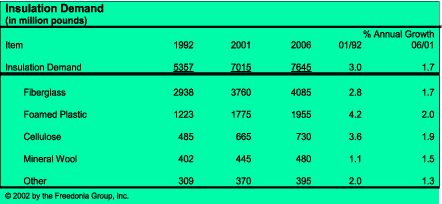U.S. Insulation Demand to Reach 7.6 Billion Pounds by 2006
The demand for thermal and acoustical insulation in the United States is expected to rise 1.7 percent annually through 2006 to 7.6 billion pounds, valued at $5.8 billion. In terms of thermal insulating value, demand for insulation is expected to reach 287 billion square feet of R-1 value. However, less ebullient prospects in residential and nonresidential construction markets will constrain demand for insulation.
In particular, new construction expenditures are expected to grow slowly, although opportunities for insulation will be generated by greater use per structure and by upgrades of insulation for existing buildings. These and other trends are presented in Insulation, a new study from The Freedonia Group, Inc., a Cleveland-based industrial market research firm.
Among the various insulation materials, foamed plastics are projected to enjoy the best growth prospects through 2006, although even for these materials gains will decelerate from the 1992-2001 period. Decelerating United States shipments of appliances and sluggish construction markets will contribute to a weaker demand for foamed plastic insulation. Through 2006, the best opportunities for foamed plastics will be for insulation of industrial and heating, ventilation and air conditioning (HVAC) equipment. Concerns about energy consumption by refrigerators, freezers and manufacturing process equipment will buoy demand for foamed plastic insulation even with low unit production of appliances.
Measured by either weight or by thermal insulating value, fiberglass insulation will continue as the leading material. Growth will decelerate from the 1992-2001 period, as sluggish construction activity over the forecast period will limit opportunities. Construction applications represented roughly 85 percent of fiberglass insulation demand in 2001.
Demand for insulation in residential construction, the largest market, is forecast to approach 160 billion square feet of R-1 value in 2006, also decelerating from the 1992-2001 pace. In the new housing segment, more intensive use of insulation per structure is expected to help offset the effect of a weaker environment for housing starts. Increases will be faster in replacement and improvement applications, as homeowners of older structures look to raise their insulation levels.
Insulation demand is projected to rise most strongly in the South through 2006, with annual increases of 2.3 percent to 109 billion square feet of R-1 value, accounting for almost 38 percent of US demand. The housing outlook in the South is one of the more favorable in the country, aiding residential demand for insulation in the region.
Information about purchasing the full 227-page study is available by calling the Freedonia Group at (440) 684-9600 or by visiting its Web Site at www.freedoniagroup.com.

